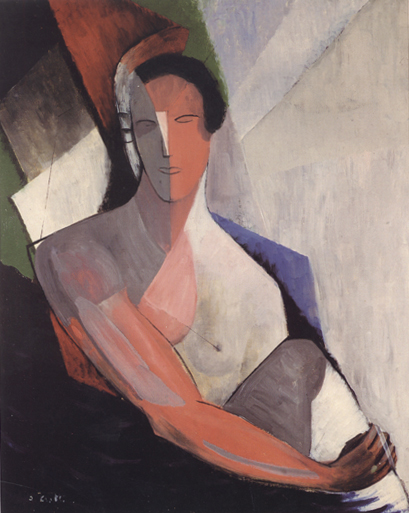

JEAN CROTTI
"ATTENTIVE AUX VOIX INTERIEURES"
OIL ON CANVAS, SIGNED
SWISS, C. 1920
CLICK HERE TO SEE RECENTLY ACQUIRED PAINTINGS
Jean Crotti's spiritual beginnings deeply affected his development as an artist. Born in 1878 in Bulle, near Fribourg in the western, French-speaking section of Switzerland, his early arts education was in Germany and France. Crotti struggled with questions of a religious and spiritual nature while at the School of Decorative Arts in Munich and the Académie Julian in Paris. As an artist, he wrote, “seems to be an instrument of God charged with transmitting messages to men....art must be therefore a kind of magic, bringing signs and messages to man...” He left school in 1902 in order to detach himself and become independent as an artist. His earliest paintings (1900-1908) are quite domestic scenes reminiscent of Bonnard and Vuillard. His work begins to show the influence of Orphism and Cubism in 1911. To escape from wartime Paris, Crotti and his wife Yvonne moved to New York city. An article in the New York Tribune (Oct. 24, 1915), “French Artists Spur on American Art,” interviewed a number of artists including Marcel Duchamp, Francis Picabia, Albert and Juliette Gleizes, and Jean Crotti, all refugees from the war who looked to America as a place where they could live and develop their art. In New York, Crotti established close friendships with Marcel Duchamp and Francis Picabia. He shared a studio with Duchamp. In 1915 there was a radical change in his work, no doubt the effect of his close working relationship with these artists. He called this moment his, “second birth by auto-procreation and self-delivery without umbilical cord.” The shift in Crotti's style was represented in the 1916 group exhibition (with Duchamp, Gleizes, and Metzinger) at the Montross Gallery. Crotti exhibited Orphist-like paintings, several of which had religious titles. Also included was his Portrait of Marcel Duchamp and his much discussed Les Forces Mécaniques de l'amour Mouvement using found objects. The latter is considered one of the earliest examples of Dada's pioneers, was making art out of Inconsequential materials. The first contact between the artists in Zurich and those in New York was a letter sent in September 1916, announcing the activities in Zurich at the Cabaret Voltaire. Crotti returned to Paris in the fall of 1916 leaving his wife Yvonne in New York. By 1917 his marriage had dissolved and two years later in Paris he married Suzanne Duchamp. Her brother, Marcel Duchamp, who was in Buenos Aires at that time, sent instructions for a “ready-made” wedding gift. The artists associated with the Dada movement were not active in Paris during the war. The French avant-garde kept abreast of Dada activities in Zurich due to the efforts of Tristan Tzara, who communicated by exchanging letters, poems, and magazineswith Guillaume Appolinaire, Max Jacob, André Breton, and other French writers, critics and artists. The first introduction of Dada to the Parisian public was at the Salon des Indépendants in 1921. Crotti exhibited works associated with Dada together with a work entitled, Explacatif bearing the word “Tabu.” In February 1921, Crotti tells of a mystical experience which was partially responsible for his latest transformation in his work. The new direction which he called “Tabu,” was presented in religious terms, its key concepts being mystery and infinity...“to express the mystery; that which cannot be seen; that which cannot be touched.” A fine example of this tabu period, Mysteere Acaténe, was shown at the Los Angeles County Museum of Art in 1986, at the much acclaimed exhibition, “The Spiritual in Art: Abstract Painting 1890-1985.” Crotti's Attentive Aux Voix Intérieures is not without this influence. The title (Listening to Interior Voices) as well as the compos tion have spiritual overtones relating it to the essence of Tabu. Intersecting angular planes are directed to the heart and at once extend upward connecting the subject (probably Suzanne Duchamp) with the infinite. Crotti's works were exhibited at the Salon d'Automne and the Salon des Indépendants from 1907-1923. He was also included in the “Exposition International” at L'Art d'Aujourd'hui, Paris 1925, and the “International Exhibiton of Modern Art” at the Brooklyn Museum, organized by the Sociéte Anonyme (1926-1927). A number of his solo exhibitions since the 1920's include: Galerie de France, Paris, 1942; Museo Caccia, Lugano, 1955; Cordier and Ekstrom Gallery, New York, 1970; Kunstmuseum Winterthur, 1972; Gimpel Fils Gallery, London 1974 and Hanover, 1974.
|